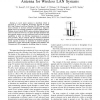Free Online Productivity Tools
i2Speak
i2Symbol
i2OCR
iTex2Img
iWeb2Print
iWeb2Shot
i2Type
iPdf2Split
iPdf2Merge
i2Bopomofo
i2Arabic
i2Style
i2Image
i2PDF
iLatex2Rtf
Sci2ools
VTC
2006
IEEE
2006
IEEE
Evaluation of a Novel Low Complexity Smart Antenna for Wireless LAN Systems
— A novel smart antenna is described, which is conceived as a low complexity inexpensive upgrade for IEEE 802.11b/g Wireless Local Area Network (WLAN) systems. Using smart antennas to increase network throughput by improved spatial reuse is not normally possible for systems using the 802.11 Medium Access Control (MAC), unless centralised channel access control is enforced. However, it is shown through simulation that the proposed antenna can have sufficient beam and null steering capabilities to allow two 802.11g transmissions to co-exist in close proximity. This is achieved with the standard distributed channel access algorithms and therefore has potential to increase system capacity. Accuracy in simulation is ensured through a combination of MAC functionality modelling using OPNET and 3 dimensional (3D) propagation modelling using ray tracing.
| Added | 12 Jun 2010 |
| Updated | 12 Jun 2010 |
| Type | Conference |
| Year | 2006 |
| Where | VTC |
| Authors | Timothy J. Harrold, Dean C. Kemp, Mark A. Beach, Chris Williams, Michael Philippakis, Martin W. Shelley |
Comments (0)

